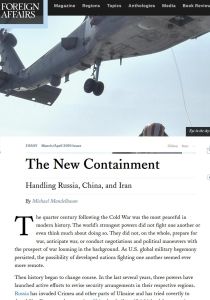Únase a getAbstract para acceder al resumen.

Únase a getAbstract para acceder al resumen.
Michael Mandelbaum
The New Containment
Handling Russia, China, and Iran
Foreign Affairs, 2019
¿De qué se trata?
America’s Cold War containment strategy provides a blueprint for dealing with 21st-century revisionist powers.
Recommendation
In an essay for Foreign Affairs in 1947, writing under the pseudonym “Mr. X,” George F. Kennan, US Chargé d’Affaires in Moscow, outlined the pillars of what would become America’s Cold War policy of “containment.” Skillfully countering the threat of Soviet expansionism, Kennan argued, would lead to “either the break-up or the gradual mellowing of Soviet power.” Almost three-quarters of a century later, foreign policy scholar Michael Mandelbaum is calling for a new policy of containment on the pages of the very same foreign policy journal. Mandelbaum’s essay may not garner the same level of attention as Kennan’s “Long Telegram,” but it offers valuable contributions to the debate on the future direction of American foreign policy.
Summary
About the Author
Michael Mandelbaum is Christian A. Herter Professor and Director of the American Foreign Policy program at the Johns Hopkins School of Advanced International Studies and the author of The Rise and Fall of Peace on Earth.





















Comment on this summary